Back to Journals » Journal of Multidisciplinary Healthcare » Volume 13
Knowledge, Attitudes, and Practices of Hand Washing among Aderash Primary Schoolchildren in Yirgalem Town, Southern Ethiopia
Authors Eshetu D , Kifle T, Hirigo AT
Received 5 April 2020
Accepted for publication 24 June 2020
Published 7 August 2020 Volume 2020:13 Pages 759—768
DOI https://doi.org/10.2147/JMDH.S257034
Checked for plagiarism Yes
Review by Single anonymous peer review
Peer reviewer comments 2
Editor who approved publication: Dr Scott Fraser
Daniel Eshetu,1 Tigist Kifle,2 Agete Tadewos Hirigo3
1Department of Microbiology, Yirgalem Hospital Medical College, Yirgalem, Ethiopia; 2College of Medicine and Health Science, Comprehensive Specialized Hospital, Hematology Unit, Hawassa University, Hawassa, Ethiopia; 3College of Medicine and Health Science, School of Medical Laboratory Sciences, Hawassa University, Hawassa, Ethiopia
Correspondence: Daniel Eshetu
Yirgalem Hospital Medical College,Department of Microbiology, Yirgalem, Ethiopia
Tel +251-917-867-385
Email [email protected]
Background: Hand washing is a simple, convenient, and cost-effective means to limit the transmission of communicable diseases. Improving the practice of hand washing is vital to decrease hygiene-related morbidity and mortality, particularly in developing countries. As such, this study aimed to assess knowledge, attitudes, and practices of hand washing among schoolchildren in Aderash primary school, Yirgalem town.
Methods: A cross-sectional study was conducted on 279 schoolchildren from March to May 2019. A pretested structured questionnaire was applied to collect all relevant information using simple random sampling. Data entry and clearance was done with Epi-Info version 7 and exported to SPSS version 20 for analysis. Adjusted ORs with 95% CI were used to assess statistically significant variables (p< 0.05).
Results: Overall, 62.7% of schoolchildren had adequate knowledge of hand washing, 61.3% exhibited positive attitudes toward hand washing and 39.1% had good hand-washing practices. Over three quarters (89%) of them had good knowledge of washing hands with soap. About 24%, 56.6%, 9.3%, 6.5%, and 3.6% of children reported washing hands after defecation, before meals, after meals, after work, and after play, respectively. In addition, 73.8% of them reported washing hands with soap if their hands looked dirty or smelled bad. Urban dwelling increased knowledge of hand washing of 1.3-fold (95% CI 1.2– 2.85).
Conclusion: Even though > 60% of children had adequate knowledge and exhibited positive attitudes toward hand washing, proper hand-washing practices was < 40%. Therefore, much effort should be directed toward improving children’s understanding of the benefits of proper hand washing in schools.
Keywords: knowledge, attitude, hand-washing practice, primary school children, Yirgalem
Introduction
Hand hygiene is a structured intervention to prevent the transmission of infectious agents. It is the act of cleaning hands to remove soil, dirt, and microorganisms from our hands with or without the application of antimicrobial soap.1 Hand washing is a simple, convenient, effective, and cost-effective means to limit the transmission of communicable diseases from one person to another.2,3 Proper hand washing also significantly reduces the transmission of conjunctivitis, trachoma, and bacteria-related respiratory diseases.4,5 The promotion of hand washing improves the sanitation of populations, mainly those who are living in developing countries.6 However, the impact of scarce and insecure water supply is a big challenge concerning sanitation and hygiene, and it may predispose individuals to bad health outcomes.7 About 80% of diseases in developing countries are associated with poor hygiene,8 and >2 million people die every year due to diarrhea, with increased death rates among children.9 Studies have indicated that proper hand washing reduces diarrhea occurrences by approximately 30%–40%10,11 and of respiratory-tract infections by 6%–44%.12 Moreover, around 60% of disease burden is linked with lack of proper sanitation and hygienic conditions in Ethiopia.13 Few schools in Ethiopia have sufficient water supply or toilet facilities for sanitation and hygiene purposes,14 the latter perhaps due to poor design and construction.14 The school toilets are not suitable, difficult to manage properly, and this situation may predispose children to open defecation instead of using these toilets Furthermore, children’s learningmay be affected by intestinal helminth infection, diarrheal diseases, and malaria infections, and these factors may force children to be absent from school.15
Despite considerable evidence on the effectiveness of hand washing, particularly with the application of soap, the practice of proper hand washing is poor in developing countries, including Ethiopia. Data regarding practices of hand washing among children in primary schools are scarce. Also, children are at risks of diarrheal diseases, acute respiratory infections, and other hygiene-related problems. Therefore, this study aimed to assess knowledge, attitudes, and practices of hand washing and their predictors among schoolchildren.
Methods
Study Area, Design, and Population
An institution based cross-sectional study was conducted on 288 schoolchildren from May to June 2019 at Aderash primary school, Yirgalem town, Southern Ethiopia. Yirgalem is located 47 km from Hawassa, capital of the Southern Nations, Nationalities, and People’s Region and 325 km from Addis Ababa, the capital city of Ethiopia. This governmental primary school provides free education for Yirgalem and nearby rural children. About 4,641 students (2,291 males and 2,170 females) started classes in the 2018–2019 academic year at this school.
Eligibility Criteria
All schoolchildren in the Aderash primary school for the 2018–2019 academic year were the source population, and grade 5–8 schoolchildren who attended classes during data collection were the study population.
Data-Collection Procedures and Laboratory Diagnosis
All relevant data were collected from schoolchildren using a pretested structured questionnaire through interviewer administration. The questionnaire covered grade, age, sex, parent’s education level, family’s monthly income, and knowledge and attitude-related questions about hand washing, as well as handwashing habits like plain hand washing, washing with soap, timing of hand washing, length of hand washing, and other related information. Moreover, instruction was given to children concerning stool sample collection and polyethylene screw-capped containers and applicator sticks given to each child to provide about 2 gram fresh stool. Subsequently, direct wet-mount microscopic examination was done in the nearby health center within 20–30 minuted of sample collection, while the leftover portion from each child’s stool sample was processed for parasite concentrations using formalin ether. Laboratory technologists managed the stool-sample collection and well as laboratory diagnosis, whereas health professionals did clinical assessments.
Knowledge, Attitudes, and Practices of Hand Washing and Operational Definitions
Knowledge of hand washing was evaluated with nine items that comprised yes/no and multiple-choice questions. Attitudes toward hand washing were evaluated with eight items consisting of yes/no questions. Hand-washing practices were assessed using five yes/noitems and multiple-choice questions.
Overall Knowledge Level
Children who scored ≥65% overall on knowledge-indicator items were categorized as “good knowledge of hand washing”, whereas those who failed to answer at least 65% of the items as “poor knowledge of hand washing.”
Overall Attitude Level
Children who scored ≥65% overall on attitude-indicator items were categorized as “positive attitudes toward hand washing”, while those who failed to answer at least 65% of the items as “negative attitudes toward hand washing.”
Overall Practice Level
Children who scored ≥65% overall on practice-indicator items were categorized as “good practices of hand washing”, and those who failed to score on at least 65% of the items as “poor practices of hand washing.”
Data-Quality Management
Before actual data collection, the quality of the questionnaire was checked by pretesting among other schoolchildren (grades 5–8). Then, amendments were done based on pretest feedback. In addition, both stool-sample collection and laboratory examination were managed as per standard operating procedures (SOPs).
Statistical Analysis
Data were coded and entered into Epi-Info version 7, then exported to SPSS version 20 for statistical analysis. Descriptive statistics (frequencies and percentages) were used to summarize sociodemographic and other characteristics of study subjects. Binary logistic regression analysis was used to indicate the strength of associations between explanatory and outcome variables. Only variables with p<0.25 on bivariate analysis were considered and included in multivariate analysis. Finally, P<0.05 on multivariate analysis was taken as statistically significant with a 95% CI.
Ethical Considerations
The Ethical Review Committee of Yirgalem Hospital Medical College (ERC/2010) approved the study. An official letter was submitted to Sidama zone Dale woreda education bureau and Aderash primary school and then permission obtained for data collection. The study was conducted in accordance with the Declaration of Helsinki for research involving human subjects. The protocol of the study was well explained to the study subjects/children’s parents and written informed consent obtained from subjects and/or from parents/legal guardians. Privacy of information was strictly preserved.
Results
Sociodemographic Characteristics of the Study Population
A total of 288 schoolchildren were approached and 279 enrolled in the study, giving a response rate of 96.9%: 150 (53.8%) were male and 200 (71.7%) urban dwellers. Of the total, 38 (13.6%), 105 (37.6%), 52 (18.6%) and 84 (30.1%) were in grades 5, grade, 7, and 8, respectively. Most 162(58.1%) were aged 13–15 years, and 107 (38.3%) of respondents’ families earned >ETB1,500 per month. A total of 51 (18.3%) and 70 (25.1%) of the children had intestinal parasites (Ascaris lumbricoides, Giardia lamblia, Taenia spp., and Hymenolepis nana) and respiratory tract infections, respectively (Table 1).
 |
Table 1 Sociodemographic Characteristics of Schoolchildren at Aderash Primary School |
Knowledge and Attitudes Toward Hand Washing
Of the total, 251 (89.9%) of schoolchildren had knowledge of washing hands with soap, but 248 (98.8%) did not know the exact date of Global Handwashing Day. In sum, 69 (27.5%), 46 (18.3%), 55 (21.9%), and 81 (32.3%) obtained knowledge of washing hands from television, teachers, family, and health workers, respectively. More than half (60.6%), 70 (25.1%), 30 (10.8%), 8 (2.9%), and 2 (0.7%) had knowledge of washing hands after defecation, before meals, after meals, after work, and after play, respectively. Overall, 175 (62.7%) had good (adequate) knowledge of hand washing (Table 2).
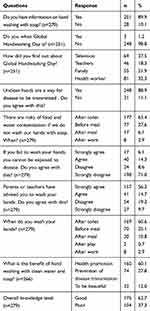 |
Table 2 Knowledge of Hand Washing Among Schoolchildren at Aderash Primary School |
A total of 216 (77.4%) children reported that human feces could not be free from germs, while the rest 63 (22.6%) did not think so. In addition, 206 (73.8%) children indicated they should wash their hands with soap if their hands looked dirty or smell bad, and 262 (96.7%) indicated the importance of washing hands with soap before meals, to avert the transmission of diseases and contamination of foods with germs. Moreover, 171 (61.3%)children exhibited positive attitudes toward proper hand washing (Table 3).
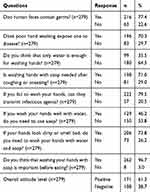 |
Table 3 Attitudes Toward Hand Washing Among Schoolchildren at Aderash Primary School |
A total of 94 (33.7%) and 81 (29%) of females and males had good knowledge of washing hands, respectively. Of those children who had good knowledge of washing hands, 16 (5.73%) had intestinal parasites, lower than the rate among children who had poor knowledge of washing hands (12.54%, Table 4). Of the total 171 children that exhibited positive attitudes toward hand washing, 99 (35.48%), 92 (32.97%), and 79 (28.32%) were aged 13–15 years and females and males, respectively (Table 5).
 |
Table 4 Knowledge of Hand Washing Among Schoolchildren in Relation to Different Variables at Aderash Primary School |
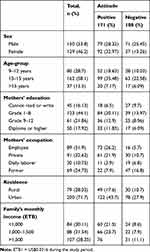 |
Table 5 Attitudes of Schoolchildren Toward Hand Washing in Relation to Different Variables at Aderash Primary School |
Hand-Washing Practices
A majoriy, 246 (88.2%) reported washing hands with soap, while 33 (11.8%) reported washing hands only with water. Of the total, 158 (56.6%), 67 (24%), 26 (9.3%), and 10 (3.6%) of children reported washing hands before meals, after defecation, after meals, and after play, respectively. In addition, 64(22.9%) reported washing their hands regularly with soap before meals (Table 6). Overall, 109 (39.1%)children had good hand washing practices, whereas 170 (60.9%) had poor hand-washing practices. Of those who had good hand-washing practices, 62 (22.2%), 64 (22.9%), and 80 (28.67%) were female, aged 13–15 years, and urban dwellers, respectively (Table 7).
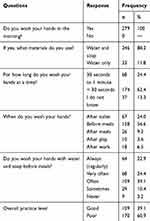 |
Table 6 Hand-Washing Practices of Schoolchildren in Aderash Primary School |
 |
Table 7 Hand-Washing Practices of Schoolchildren in Relation to Different Variables in Aderash Primary School (n=109) |
Factors Affecting Knowledge, Attitudes, and Practices of Hand Washing
Initially, bivariate analysis was done and independent variables with p<0.25 were included in multivariate analysis to assess factors strongly associated with the study outcome. Age 9–12 years (AOR 0.4, 95% CI 0.17–0.95), urban dwelling (AOR 1.3, 95% CI 1.2–2.85), mother’s occupation (AOR 0.05, 95% CI 0.01–0.8), and mother’s education level (AOR 0.3, 95% CI 0.10–0.8) were associated with knowledge of hand washing. In addition, age 9–12 years (AOR 0.1, 95% CI 0.03–0.3), mother’s occupation (AOR 0.05, 95% CI 0.01–0.3), and mother’s education (AOR 0.3, 95% CI 0.10–0.74) were also associated with the practice of hand washing. However, attitudes of children toward hand washing did not show associations with independent variables (Table 8).
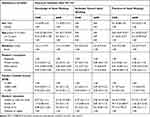 |
Table 8 Factors Associated with Knowledge, Attitudes, and Practices of Hand Washing Among Schoolchildren in Aderash Primary School |
Discussion
Hand hygiene is the act of washing hands only with water or with the application of antimicrobial soap.1 Hand washing is the single most preventive means of the spread of infectious organisms from one person to another. Based on the study criteria, 62.7% of the children had adequate knowledge of washing hands. This finding was higher than a study conducted in northern Ethiopia, which found 52%.16 Also, the finding was lower than studies conducted in Hosanna, southern-Ethiopia17 and India,18 in which rates were 69.9% and 77%, respectively. The variations might be attributed to differences in awareness creation, scale of classification, and the number of enrolled subjects.
In this study, 61.3% of the schoolchildren had positive attitudes toward hand washing. This finding was almost comparable with the studies conducted in other parts of Ethiopia: 59.4% in Hosanna17 and 61.7% in northern Ethiopia.19 However, it was lower than one conducted in South Africa,20 in which 91.4% of schoolchildren had positive attitudes toward hand washing. A large number of students from different schools in South Africa participated, while children from a single school were included in the current study, and this might be a good reason for the variation.
In this study, overall 39.1% of children had good practices of hand washing. This finding was lower than that reported from southern Ethiopia — 71.97%.17 The variation might be attributed to the classification scale for hand-washing practices. That study used a 60% score as the cutoff for classification of hand-washing practices, whereas a 65% score was used in the current study as cutoff, and this might be a plausible reason for the variations in hand-washing practices between these studies.
The study conducted in north Ethiopia revealed 99% and 76.9% of respondents washed their hands before meals and after defecation, respectively.16 In contrast, 56.6% and 24% of our children reported washing their hands before meals and after defecation, respectively. In the present study, 88.2% of children reported washing their hands with soap. Similarly, 91.5% of children in Mumbai21 and 94.5% of children in Duwakot22 washed their hands with soap. In contrast, lower rates of washing hands with soap were reported by schoolchildren in several studies: 9.9% in public schools in Kintampo municipality, Ghana,23 21.3% in Bangalore and Kolkata schools in India,24 and 40% in rural schools of Nalgonda and Andhra Pradesh in India.25 In addition, 47.3%24 and 41.2%25 of children washed their hands only with water. The variations may be due to awareness levels of children regarding the benefits of hand washing with soap.
In the present study, about 76% of children reported not washing their hands after defecation. This finding was nearly compatible with a study conducted in Mereb-Leke district, northern Ethiopia, which indicated >70% of children did not wash their hands after defecation.19 In the present study, children from urban areas were 1.3 times more likely to have good knowledge of hand washing (95% CI 1.2–2.85) than children from rural areas. This finding was consistent with the previous study conducted in Hosanna, Southern Ethiopia.17 Our study indicated that sex was not associated with the practice of hand washing. This finding was similar to a study conducted in Sebeta town, Oromia region.26 Whereas this finding was not in line with two other studies,17,27 taht indicated an association between female sex and good hand-washing practices.The reason might be females pay more attention toward beauty and hygiene than males.
Furthermore, this study indicated 18.3% prevalence of intestinal parasite infection. This finding was inconsistent with the several studies conducted in Ethiopia: 60.7% in Tigray,28 77.9% in Amhara region,29 84.3% in East Gojjam zone,30 79.8% in north Gondar,31 and 62.2% in the Southwest, Ethiopia.32 The knowledge gap of children concerning the transmission route of intestinal parasites and preventive measures among the studies could be responsible for the disparity in intestinal parasite infection rates. Also, the incidence of intestinal parasites might show variability across geographical locations, environmental sanitation, and personal hygiene.
Limitations
This study confronted some limits that may affect the generalizability of findings. First, we did this study at a single school, so the findings cannot be apllied to the general population of all schoolchildren. Second, since the study design was cross-sectional, it referenced only a single point in time. Third, the study assessed the practice of hand washing using self-response, and this might have caused recall bias. Regardless of these limits, this study ultimately adds supportive evidence to areas where there have been insufficient data.
Conclusion
Though >60% of the schoolchildren had good knowledge and exhibited positive attitudes toward hand washing, the practice of proper hand washing was<40%. Urban dwelling increased the odds of knowledge of hand washing 1.3 times. Therefore, sustainable health education in schools is vital to equip children with knowledge and healthy attitudes toward hand hygiene. Moreover, the availability of standardized latrines, sufficient water-supply systems, and antimicrobial soap in the schools play an important role to enhance proper hand-washing practices. Furthermore, extensive controlled studies are required to address other potential factors that contribute to knowledge, attitudes, and practices of hand hygiene.
Data-Sharing Statement
The data set of this article is not openly accessible. However, it is accessible upon reasonable request from the corresponding author with the authorization of the Yirgalem Hospital Medical College ethics committee.
Acknowledgments
We want to acknowledge the Aderash primary school teachers for their great support during data collection. Further, our appreciation is also extended to the study subjects for their voluntary involvement in the study.
Author Contributions
All authors contributed toward data analysis, drafting, and revision, gave final approval to the version to be published, and agree to be responsible for all aspects of the work.
Disclosure
The authors declare that they have no conflict of interest in this work.
References
1. Burton M, Cobb E, Donachie P, et al. The effect of hand washing with water or soap on bacterial contamination of hands. Int J Environ Res Public Health. 2011;8(1):97–104. doi:10.3390/ijerph8010097
2. USAID. Hygiene Improvement Project (HIP) -Tippy-Tap: A Simple Low-Cost Technology for Hand Washing When Water is Scarce. 2010.
3. Core H. Hand Hygiene in Healthcare Settings: An Overview of Health Care Hand Washing. 2002:1–27.
4. Tadesse B, Worku A, Kumie A, et al. Effect of water, sanitation and hygiene interventions on active trachoma in North and South Wollo zones of Amhara Region, Ethiopia: a quasi-experimental study. PLoS Negl Trop Dis. 2017;11(11):e0006080. doi:10.1371/journal.pntd.0006080
5. Mbakaya BC, Lee PH, Lee RLT. Hand hygiene intervention strategies to reduce diarrhoea and respiratory infections among schoolchildren in developing countries: a systematic review. Int J Environ Res Public Health. 2017;14(4):371. doi:10.3390/ijerph14040371
6. Sijbesma C, Christoffers T. The value of hygiene promotion: cost-effectiveness analysis of interventions in developing countries. Health Policy Plan. 2009;24(6):418–427. doi:10.1093/heapol/czp036
7. Nath KG. Impact of Inadequate Sanitation and Poor Level of Hygiene Perception and Practices on Community Health. New Delhi: Sulabh International Academy of Environmental Sanitation; 2009.
8. WHO. Burden of Disease and Cost Effectiveness Estimates. 2006.
9. Scott B, Curtis V, Rabie T, et al. Health in our hands, but not in our heads: understanding hygiene motivation in Ghana. Health Policy Plan. 2007;22(4):225–233. doi:10.1093/heapol/czm016
10. Freeman MC, Stocks ME, Cumming O, et al. Systematic review: hygiene and health: systematic review of handwashing practices worldwide and update of health effects. Trop Med Int Health. 2014;19(8):906–916. doi:10.1111/tmi.12339
11. Ejemot-Nwadiaro RI, Ehiri JE, Arikpo D, et al. Hand washing promotion for preventing diarrhoea. Cochrane Database Syst Rev. 2015. doi:10.1002/14651858
12. Rabie T, Curtis V. Hand washing and risk of respiratory infections: a quantitative systematic review. Trop Med Int Health. 2006;11(3):258–267. doi:10.1111/j.1365-3156.2006.01568.x
13. Education Sector Development Program III (ESDP III). 2005/2006-2010/2011 (1998 EFY - 2002 EFY): program action plan (PAP): final draft. Available from: http://planipolis.iiep.unesco.org/en/2005/education-sectordevelopment-program-iii-esdp-iii-20052006-20102011-1998- efy-2002-efy-program.
14. UNICEF. Design and construction manual for water supply and sanitary facilities in primary schools. Ministry of Health, Education and Water & Energy in Collaboration withUNICEF; 2010.http://www.unicef.org/wash/schools/files/WASH_in_Schools_Desig_Manual.pdf.
15. Federal Democratic Republic of Ethiopia Ministry of Health. Review of Policy Documents on Climate Change, WASH and Public Health in Ethiopia. Addis Ababa Ethiopia; 2015.
16. Vivas AP, Gelaye B, Aboset N, et al. Knowledge, attitudes, and practices (KAP) of hygiene among school children in Angolela, Ethiopia. J Prev Med Hyg. 2010;51(2):73–79.
17. Buda AS, Mekengo DE, Lodebo TM, et al. Knowledge, attitude and practice on hand washing and associated factors among public primary schools children in Hosanna town, Southern Ethiopia. J Public Health Epidemiol. 2018;10(6):205–214. doi:10.5897/JPHE2017.0987
18. Ariyaratne MHJD, Gunasekara TDCP, Weerasekara MM, et al. Knowledge, attitudes and practices of hand hygiene among final year medical and nursing students at the University of Sri Jayewardenepura. Sri Lanka J Infect Dis. 2013;3(1):15–25. doi:10.4038/sljid.v3i1.4761
19. Assefa M, Kumie A. Assessment of factors influencing hygiene behavior among school children in Mereb-Leke District, Northern Ethiopia. BMC Public Health. 2014;14(1):1000. doi:10.1186/1471-2458-14-1000
20. Sibiya JE, Gumbo JR. Knowledge, attitude and practices (KAP) survey on water, sanitation and hygiene in selected schools in Vhembe District, Limpopo, South Africa. Int J Environ Res Public Health. 2013;10(6):2283–2295. doi:10.3390/ijerph10062282
21. Gawai PP, Sachin A, Ameeta S, et al. A cross-sectional descriptive study of hand washing knowledge and practices among primary school children in Mumbai, Maharashtra,India. Int J Community Med Public Health. 2016;3(10):2958–2966. doi:10.18203/2394-6040.ijcmph20163391
22. Manandhar P, Chandyo RK. Hand washing knowledge and practice among school going children in Duwakot, Bhaktapur: a cross-sectional study. J Kathmandu Med Coll. 2017;6(21):110–115. doi:10.3126/jkmc.v6i3.19827
23. Dajaan DS, Addo HO, Ojo L, et al. Hand washing knowledge and practices among public primary schools in the Kintampo Municipality of Ghana Int J Community Med Public Health. 2018;5(6):2205–2216.
24. Ray SK, Srikanth J, Amarchand R. A study on prevalence of bacteria in the hands of children and their perception on hand washing in two schools of Bangalore and Kolkata. Indian J Public Health. 2011;55(4):293–297. doi:10.4103/0019-557X.92408
25. Takalkar AA, Nirgude AS, Nagaraj K, et al. Hand hygiene perception and practices of school going children from rural Government schools of Nalgonda, Andhra Pradesh. Int J Med Health Sci. 2013;2(2):154–160.
26. Mekonnen M, Aga F, Kinati T, et al. Assessment of hand washing practice and associated factors among primary school children in Sebeta Town Oromia Regional State, Ethiopia. Health Sci J. 2018;12(6):1–6. doi:10.21767/1791-809X.1000605
27. Tadesse G. The prevalence of intestinal helminthic infections and associated risk factors among school children in Babile town, eastern Ethiopia. Ethiop J Health Dev. 2005;19(2):141–147. doi:10.4314/ejhd.v19i2.9983
28. Kidane E, Menkir S, Kebede A, et al. Prevalence of intestinal parasitic infections and their associations with anthropometric measurements of school children in selected primary schools, Wukro Town, Eastern Tigray, Ethiopia. Int J Curr Microbiol Appl Sci. 2014;3(3):11–29.
29. Alamir M, Awoke W, Feleke A. Intestinal parasites infection and associated factors among school children in Dagi primary school, Amhara National Regional State, Ethiopia. Health. 2013;2013.
30. Workneh T, Esmael E, Ayichiluhm M. Prevalence of intestinal parasitic infections and associated factors among Debre Elias primary school. East Gojjam zone Amhara region, north-West Ethiopia. J Bacteriol Parasitol. 2014;5(181):11–19. doi:10.4172/2155-9597.1000181
31. Asrat A, Tewodros D, Alemayehu W. Prevalence and risk factors of IPs among Delgi school children, northern Gonder, Ethiopia. J Parasitol Vector Biol. 2011;3(5):75–81.
32. Sitotaw B, Shiferaw W. Prevalence of intestinal parasitic infections and associated risk factors among the first-cycle primary school children in Sasiga District, Southwest Ethiopia. J Parasitol Res. 2020;2020:1–13. doi:10.1155/2020/8681247
 © 2020 The Author(s). This work is published and licensed by Dove Medical Press Limited. The full terms of this license are available at https://www.dovepress.com/terms.php and incorporate the Creative Commons Attribution - Non Commercial (unported, v3.0) License.
By accessing the work you hereby accept the Terms. Non-commercial uses of the work are permitted without any further permission from Dove Medical Press Limited, provided the work is properly attributed. For permission for commercial use of this work, please see paragraphs 4.2 and 5 of our Terms.
© 2020 The Author(s). This work is published and licensed by Dove Medical Press Limited. The full terms of this license are available at https://www.dovepress.com/terms.php and incorporate the Creative Commons Attribution - Non Commercial (unported, v3.0) License.
By accessing the work you hereby accept the Terms. Non-commercial uses of the work are permitted without any further permission from Dove Medical Press Limited, provided the work is properly attributed. For permission for commercial use of this work, please see paragraphs 4.2 and 5 of our Terms.
